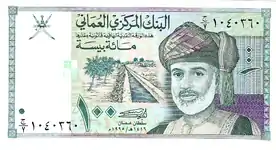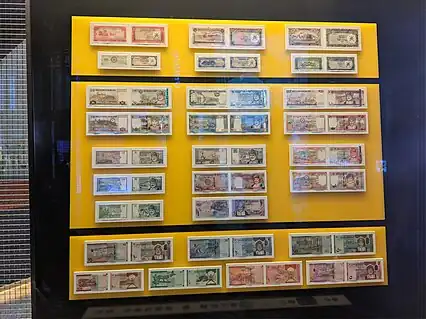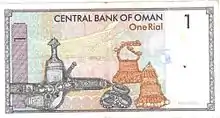Omani rial
The Omani rial (Arabic: ريال, ISO 4217 code OMR) is the currency of Oman. It is divided into 1000 baisa (also written baiza, بيسة).
| ريال عماني (Arabic) | |
|---|---|
| ISO 4217 | |
| Code | OMR (numeric: 512) |
| Subunit | 0.001 |
| Unit | |
| Symbol | ر.ع. R.O or ﷼ |
| Denominations | |
| Subunit | |
| 1⁄1000 | baisa |
| Banknotes | |
| Freq. used | 100 baisa, 1⁄2, 1, 5, 10, 20, 50 rials |
| Coins | |
| Freq. used | 5, 10, 25, 50 baisa |
| Demographics | |
| User(s) | |
| Issuance | |
| Central bank | Central Bank of Oman |
| Website | cbo |
| Valuation | |
| Inflation | 4.1% |
| Source | The World Factbook, 2011 est. |
| Pegged with | US dollar (USD)[1] 1 USD = 0.384497 OMR |
Fixed exchange rate
From 1973 to 1986, the rial was pegged to the U.S. dollar at 1 Omani rial = US$2.895. The rate was changed in 1986 to 1 Omani rial = US$2.6008,[2] which translates to approximately US$1 = 0.384497 rial. The Central Bank of Oman buys U.S. dollars at 0.384 Omani rial, and sells U.S. dollars at 0.386 Omani rial.[3] It is the third-highest-valued currency unit in the world after the Kuwaiti dinar and the Bahraini dinar.
| Current OMR exchange rates | |
|---|---|
| From Google Finance: | AUD CAD CHF CNY EUR GBP HKD JPY USD INR CNY KRW |
| From Yahoo! Finance: | AUD CAD CHF CNY EUR GBP HKD JPY USD INR CNY KRW |
| From XE.com: | AUD CAD CHF CNY EUR GBP HKD JPY USD INR CNY KRW |
| From OANDA: | AUD CAD CHF CNY EUR GBP HKD JPY USD INR CNY KRW |
Note: Rates obtained from these websites may contradict with pegged rate mentioned above.
History
Until 1940, the Indian rupee and the Maria Theresa thaler (known locally as the rial due to its similar size to the Spanish eight-real coin) were the main currencies circulating in Muscat and Oman, as the state was then known, with Indian rupees circulating on the coast and thaler in the interior. Maria Theresa thaler were valued at 230 paisa, with 64 paisa = 1 rupee.[4]
In 1940, coins were introduced for use in Dhofar, followed, in 1946, by coins for use in Oman. Both coinages were denominated in baisa (equivalent to the paisa), with 200 baisa = 1 rial. The Indian rupee and, from 1959, the Gulf rupee continued to circulate. On 6 June 1966, India devalued the Gulf rupee against the Indian rupee. Following the devaluation, several of the states still using the Gulf rupee adopted their own currencies. Oman continued to use the Gulf rupee until 1970, with the government backing the currency at its old peg to the pound, when it adopted the Saidi rial.
On 7 May 1970[5][6] the Saidi rial (named after the House of Al Said, not to be confused with Saudi riyal) was introduced as the currency of Oman to replace the Gulf rupee. It was equal to the British pound sterling and 1 Saidi rial = 21 Gulf rupees. The Saidi rial was subdivided into 1000 baisa. The Omani rial replaced the Saidi rial at par on 11 November 1972.[6][7][8] At that time, the currency became pegged to the US dollar at 1 Omani rial = US$2.895, instead of the pound sterling, a rate that would continue until 1986, when it was devalued by about 9% to 1 Omani rial = US$2.6008. The currency name was altered due to the regime change in 1970 and the subsequent change of the country's name. Since 1975, new coins have been issued with the country's name given as Oman.
Coins
In the 1890s, coins for 1⁄12 and 1⁄4 anna (1⁄3 and 1 paisa) were minted specifically for use in Muscat and Oman.
In 1940, coins were issued for use in Dhofar in denominations of 10, 20 and 50 baisa. 1⁄2 rial coins were added in 1948, followed by 3 baisa in 1959. In 1946, 2, 5 and 20 baisa coins were introduced for use in Oman. These were followed, between 1959 and 1960, by 3 baisa, 1⁄2 and 1 rial coins.
In 1970, a coinage for all of Muscat and Oman was introduced. Denominations were 2, 5, 10, 25, 50 and 100 baisa. In 1975, new coins were issued with the country's name given as Oman. 1⁄4 and 1⁄2 rial coins were introduced in 1980.
Coins currently circulating are 5, 10, 25 and 50 baisa
Coins with the value of 100 baisa and above lost their monetary value on 20 May 2020.[9]
| Omani Qaboos coins | |||||||||
|---|---|---|---|---|---|---|---|---|---|
| Image | Value | Diameter | Mass | Composition | Edge | Obverse | Reverse | Year of | |
| Obverse | Reverse | first minting | |||||||
| 5 baisa | 19 mm | 2.65 g | Copper-clad steel | Smooth | Qaboos bin Sa'id, Sultan of Oman | Year of minting | 1999 | ||
| 10 baisa | 22.5 mm | 4.1 g | Copper-clad steel | Smooth | Qaboos bin Sa'id, Sultan of Oman | Year of minting | 1999 | ||
| 25 baisa | 22.5 mm | 2.63 g | Nickel-plated steel | Reeded | Qaboos bin Sa'id, Sultan of Oman | Year of minting | 1999 | ||
| 50 baisa | 24 mm | 5.57 g | Nickel-plated steel | Reeded | Qaboos bin Sa'id, Sultan of Oman | Year of minting | 1999 | ||
| 100 baisa | 21.5 mm | 4.20 g | Copper-nickel | Reeded | Sultanate of Oman | Year of minting | 1984 | ||
| 1⁄4 riyal | 26 mm | 6.5 g | Aluminium bronze | Lettered | Sultanate of Oman | Year of minting | 1979 | ||
| 1⁄2 riyal | 30 mm | 10 g | Aluminium bronze | Reeded | Sultanate of Oman | Year of minting | 1979 | ||
.jpg.webp)

Banknotes
On 7 May 1970, the Sultanate of Muscat and Oman issued banknotes in denominations of 100 baisa, 1⁄4, 1⁄2, 1, 5 and 10 rial saidi.[10] These were followed by notes for 100 baisa, 1⁄4, 1⁄2, 1, 5 and 10 Omani rials issued by the Oman Currency Board on 18 November 1972.[11]
From 1977, the Central Bank of Oman has issued notes, with 20 and 50 rial notes introduced that, followed by 200 baisa notes in 1985.
A new series of notes was issued on 1 November 1995, and the 5-rial notes and higher were updated in 2000 with foil strips.
In 2005, a red 1 rial note commemorating the "35th National Day" was issued.
In 2010, new 5, 10, 20 and 50-rial notes were issued on the occasion of the 40th National Day. The 20-rial note is blue instead of green while the other notes are the same colour as previously.
In 2015, a purple 1 rial note commemorating the "45th National Day" was issued.[12]
After 30 July 2019, all banknotes issued before 1 November 1995 became invalid, as well as the 5 to 50 rial banknotes issued on that date without foil strips. The 5 to 50 rial banknotes of the 1995 series with foil strips, released into circulation from 2000, remain valid.[13] Thus, as of 2020, banknotes in circulation are mainly the 2010 series of 5 to 50 rial, the 2015 1-rial note, and the 1995 series of 100 baisa and 1⁄2 rial. The 1995 200-baisa note, the 1995 and 2005 1-rial notes, and the 2000 release of 5-50 rial notes are still accepted but not commonly seen. Coins in circulation are mainly 25 and 50 baisa, with 5 and 10 baisa used in shops whose pricing requires them.

A new series of banknotes has been released with sultan Haitham bin Tariq on the obverse.
| 1973 Series | |||||
|---|---|---|---|---|---|
| Image | Value | Main Colour | Description | ||
| Obverse | Reverse | Obverse | Reverse | ||
| 100 baiza | Brown | ||||
| 1⁄4 rial | Blue | ||||
| 1⁄2 rial | Green | ||||
| 1 rial | Red | ||||
| 5 rials | Purple | ||||
| 10 rials | Brown-Black | ||||
| 1977 Series | |||||
|---|---|---|---|---|---|
| Image | Value | Main Colour | Description | ||
| Obverse | Reverse | Obverse | Reverse | ||
| 100 baiza | Orange | ||||
| 200 baiza | Purple | ||||
| 1⁄4 rial | Blue | ||||
| 1⁄2 rial | Green | ||||
| 1 rial | Red | ||||
| 5 rials | Maroon | ||||
| 10 rials | Brown-Black | ||||
| 20 rials | Dark Green | ||||
| 1985 Series | |||||
|---|---|---|---|---|---|
| Image | Value | Main Colour | Description | ||
| Obverse | Reverse | Obverse | Reverse | ||
| 100 baiza | Red-Brown | ||||
| 200 baiza | Purple | ||||
| 1⁄4 rial | Blue | ||||
| 1⁄2 rial | Green | ||||
| 1 rial | Red | ||||
| 5 rials | Maroon | ||||
| 10 rials | Dark Brown | ||||
| 20 rials | Brown-Black | ||||
| 50 rials | Dark Green | ||||
| 1995 Series | |||||
|---|---|---|---|---|---|
| Image | Value | Main Color | Description | ||
| Obverse | Reverse | Obverse | Reverse | ||
 |
 |
100 baisa | Green | Sultan Qaboos bin Said al Said, irrigation canal | Verreaux eagle, white oryx |
.jpg.webp) |
.jpg.webp) |
200 baisa | Blue | Sultan Qaboos bin Said Al Said, the old terminals of Salalah Airport and Muscat International Airport | Marine Science & Fisheries Center, Port Qaboos, Muttrah |
| 1⁄2 rial | Brownish-purple | Sultan Qaboos bin Said Al Said, Bahla fortress | Al-Hazim fort, Nakhal Fort | ||
 |
 |
1 rial | Purple | Sultan Qaboos bin Said Al Said, Sultan Qaboos Sports Complex | Omani Khanjar (dagger), silver bracelets and ornaments, dhows |
| 5 rials | Orange-Red | ||||
| 10 rials | Brown | ||||
| 20 rials | Green | ||||
| 50 rials | Pink & Violet | ||||
| 2005 Series / 35th National Day | |||||
| 1 rial | Pink-Purple | ||||
| 2010 Series / 40th National Day | |||||
.jpg.webp) |
.jpg.webp) |
5 rials | Red | Sultan Qaboos bin Said Al Said, Sultan Qaboos University | Nizwa |
| 10 rials | Brown | Sultan Qaboos bin Said Al Said, Al-Nahda tower | Muttrah Fort | ||
| 20 rials | Blue | Sultan Qaboos bin Said Al Said, Sultan Qaboos Grand Mosque (Muscat) | Royal Opera House Muscat | ||
| 50 rials | Pink & violet | Sultan Qaboos bin Said Al Said, Ministry of Finance and Economy Building (Muscat) | Cabinet building and Ministry of Finance and Industry building (Muscat) | ||
| 2015 Series / 45th National Day | |||||
|---|---|---|---|---|---|
| Image | Value | Main Colour | Description | ||
| Obverse | Reverse | Obverse | Reverse | ||
| 1 rial | Purple | ||||
| 2020 Series[14] | |||||
|---|---|---|---|---|---|
| Image | Value | Main Colour | Description | ||
| Obverse | Reverse | Obverse | Reverse | ||
| 100 baisa | Brown | Terraces of Jebel Akhdar, national emblem | Coconut trees (Dhofar), Falaj Al-Jeela (Ash Sharqiyah South) | ||
| 1⁄2 rial | Green | Ain Khor (Dhofar), Frankincense (Dhofar), national emblem | Arabian leopard (Dhofar), sooty falcon (Muscat & Al Batinah South) | ||
| 1 rial | Red | Oman Across Ages Museum (Ad Dakhiliyah), national emblem | Khasab Castle (Musandam), Wadi Al-Ayn Tombs (Ad Dhahirah), Jirz axe (Musandam), Omani khanjar | ||
| 5 rials | Pink-Red | ||||
| 10 rials | Brown | ||||
| 20 rials | Blue | ||||
| 50 rials | Green-Grey | ||||
See also
References
- "CBO Annual Report 2014" (PDF). Retrieved 14 June 2019.
- Chapter six, CBO Annual Report 2003
- Daily exchange rate, Central Bank of Oman
- "Global Financial Data". Archived from the original on 2007-09-26. Retrieved 2007-03-15.
- Central Bank of Oman - Currency Museum
- Omani rial at Exchange Currency
- Oman at Encyclopedia.com
- Currency of Oman: Omani rial at Mataf
- "These coins will be cancelled by the Central Bank of Oman".
- Linzmayer, Owen (2012). "Muscat and Oman". The Banknote Book. San Francisco, CA: www.BanknoteNews.com.
- Linzmayer, Owen (2012). "Oman". The Banknote Book. San Francisco, CA: www.BanknoteNews.com.
- "Oman banknotes - Oman paper money catalog and Omani currency history".
- "Old banknotes will not be valid after one month: Central Bank of Oman".
- "New Banknotes Go into Circulation Starting Today". Virgin Radio Oman. 11 January 2021. Retrieved 11 September 2022.
External links
- Information on Omani currency (archived 25 January 2005)
- Omani Ministry of Foreign Affairs
- The banknotes of Oman (in English and German)
| Preceded by: Gulf rupee Ratio: 1 rial = approximately 21 rupees = 1 British pound |
Currency of Oman 1970 – Note: known as "rial Saidi" before 1973, since known as "rial Omani" |
Succeeded by: Current |